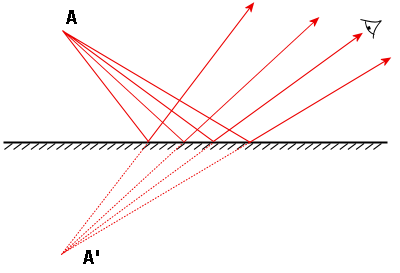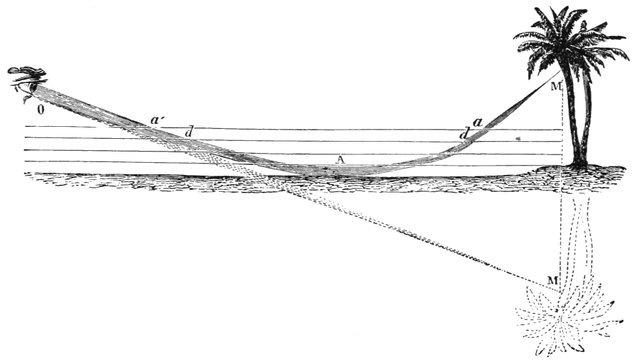The Physics of Mirage(An Optical Illusion)
Hello Steemians, it’s good to have you here again in my blog. First, I will like to commend every member of the @steemstem community for the improved engagement within the community. However, we have to continue to improve on this and stay consistent. By so doing, I’m certain SteemSTEM will grow into that community which we all dream to have. Speaking of growing the community, @kryzsec started a challenge on Hyperloop to aid this. I think this is going to be an interesting challenge. You can check out the article here . Also, expect my entry before the end of the week. Now let’s go into the business of today.
Yesterday afternoon, I had to make a journey from Abeokuta to Lagos. It was a very sunny afternoon. Sunny afternoon in Abeokuta is always scorching. Whenever, I travel through long distance, I love to sit in the front passenger seat to get a better view of the happenings on the road. Besides, the rear passenger seats are not really that conducive. For most of the journey we were on the highway and I was able to catch every detail on the road.
At one point, I began to see pool of water ahead of our car, and the reflection of roadside trees ahead in it, but upon getting to that spot there was no water and neither was there any reflection. Instead, the pool was ahead again and yet again, upon getting to this spot, there was no water. But why? Are my eyes playing tricks with me? Of course not. It is simply an optical phenomenon. Probably you always observe it as well when you travel along a tarred road and you wonder what it is called or what causes it.
Well, in this article, I will explain the physics behind this optical phenomenon which is known as Mirage. However, let’s go through some basic theories in optics. It is essential that we review the following concepts to get a better understanding on how Mirages form.
BASIC THEORIES OF LIGHT
- Light Medium
A medium is a region in space or any material through which light may or may not be allowed to pass and based on this, a medium can be transparent, translucent or opaque. A transparent medium is that which allows a substantial amount of light to pass through. One very known example of transparent medium is glass. Translucent medium on the other hand allows only a considerable amount of light to travel through them. You can consider a translucent medium as semitransparent. Opaque mediums are those that do not allow light to pass through them, instead they absorb or reflect light.
I’m sure you are familiar with the just discussed concepts as well as some yet to be discussed. However, let’s take things in a stepwise manner.
- Reflection
Reflection is the image of an object. To one degree or the other, we’ve all had reasons to use a mirror. Every morning when we dress for work or any of our daily endeavor we usually check on ourselves with mirrors. What you see in the mirror is your reflection - you actually know that. The ladies are specialist in this area. I have a friend who wakes up at 5:00 AM to attend a class starting by 8:00 AM just to give allowance for her make-over. That been said, we have depended on the phenomenon of Reflection that even I feel I should say nothing about it. However, let me add some technicality.
First, we need to understand the concept behind human vision. This is quite simple. When we see any object, rays of light emanate from that object and enters into our eyes. This is what gives the feeling of vision. Hence our vision is due to the rays coming from the objects we see. We are able to see through transparent mediums like glass because the light emanating from objects behind them is able to pass through the medium and enter into our eyes.
Now let’s consider the image to the left above. “A” is placed in the front of a plane Mirror as shown. Light rays emanate from “A” and then strikes the plane surface of the mirror. These rays become reflected (i.e. bounced away) and then goes into the eye of the observer. The image is formed at point A’ and thus the rays appears to be emanating from Point A’.
- Refraction
.png)
Image created by me (@temitayo-pelumi)
Refraction is simply the distortion of light rays when travelling from one medium to another medium. You will observe that a stick partially dipped into water will appear bent. This is because the rays of light emanating from the portion of the stick in the water (one medium) has to change direction as it travels from water into air (another medium) above the water surface. Let’s give a technical illustration of refraction.
Consider another image just above. Let’s assume that the dividing plane as shown is the boundary between glass and air. We all know that the speed of light is dependent on the medium through which it travels. When light travels through glass it has a certain speed. Upon entering into the air, the speed of light changes and the direction of travel changes as a result of this. This change in direction of the light by virtue of change in speed occurring when light crosses a boundary between two different medium is called Refraction - Just a more technical definition.
The rays directed onto the plane is called the Incident ray and that which results after crossing the plane is the Refracted ray. If we draw a normal (i.e. a perpendicular line) to this dividing plane, the angle made by the incident ray is called the angle of incidence. Of course, that made by the refracted ray is called the angle of refraction. Note that when light crosses the plane, some of the light rays are reflected, although such reflection is weak but can become strong if we have the appropriate angle of incidence. We will discuss that soon as it is the basis for Mirage to occur.
- Refractive Index
Refractive Index is the ratio of the Sine of the angle of incidence to the sine of the angle of refraction – (Don’t panic, I don’t intend to go into any analysis). Refractive index is thus a function of what goes on between two media and also on the type of light used. If the incident ray is through glass and the refracted ray is through air, then we say the Refractive index is from glass to air.
Refractive index can be determined for each medium independent of the other medium. That is, we can have the refractive index of air and that of glass independently. This is known as “Absolute Refractive Index”. To determine the absolute refractive index, we take the first medium as vacuum and the medium of interest is taken as the second medium.
The Refractive index is a measure of how light ray is bent away or towards the normal to the plane. A medium with high refractive index will bend light towards the normal while a medium with low refractive index will bend light away from the normal. Air has a lower refractive index than glass and thus will bend the light away from the normal as shown. Otherwise, the refraction would have been towards the normal.
TOTAL INTERNAL REFLECTION
Let’s now discuss the principle behind Mirage. This principle is called total internal reflection. It is a case whereby instead of the usual case of refraction when light travels through two distinct media, a strong reflection occurs.
.png)
Image created by me (@temitayo-pelumi)
Consider the previous image and that just above where an incident ray of light passing through one medium (glass) crosses the boundary between this medium and another medium (air). The light is refracted away from the normal and a weak reflected ray is observed. If we increase the angle of incidence gradually, the angle of refraction also increases i.e. the refracted ray is bent farther away from the normal. A point is reached when the angle of refraction becomes 90 degrees. The corresponding angle of incidence is called the critical angle. When this critical angle is exceeded, no refraction occurs and the reflected ray becomes strong. This phenomenon is what is called Total internal reflection (see the figure on the right in the image just above).
It is noteworthy that Total Internal Reflection occurs only when light travels from a medium of high refractive index to a medium of low refractive index.
Now that we have established the principles needed let’s move on to explain Mirage.
THE PHYSICS OF MIRAGE
Points to take note: The principle of mirage is based on refraction which we know occur when light travels from one medium to another. Now, what will happen if light travels through several distinct media with each refracted ray serving as the incident ray for the next dividing plane? Also, remember that as we increase the angle of incidence we are approaching Total Internal Reflection, which will occur eventually if we exceeds the critical angle.
.png)
Image created by me (@temitayo-pelumi)
I mentioned at the beginning of this article that It was sunny during my journey, but what has the sun got to do with Mirage? Absolutely everything. The sun heats up the tar on the road surface and air in contact with the road surface become extremely hot (see the image just above). As we go away from the road surface, the temperature of air is decreasing until we are well above the road where the temperature is colder. By virtue of this temperature difference, we now have different segment of air, with each segment having its own temperature.
You can picture each segment as a medium. So now we have series of medium laying over each other. The segment close to the road surface has the least density since it is the hottest and the density increases as we progress upwards. Note that the segments are much more in reality than what is shown.
Now, how do we see pool of water? And why do we see inverted Images of trees ahead? Even if it’s only an illusion, we see it. Here is how.
When rays of light travel from the tree ahead (refer to the image just above and that below), it is directed (i.e. an incident ray) towards the uppermost air segment. The rays pass through this segment and crosses the plane between this segment and the next segment. The rays become refracted in this new segment away from the normal – it is refracted away because hotter air has lower refractive index than colder air.
Remember I said this refracted ray becomes the incident ray for the next plane. Since this new incidence ray has be bent away from the normal, the angle of incidence is greater than that in the first segment. When this ray cross the next segment, it becomes bent farther away from the normal and the angle of incidence is even more than the initial two. This process continuous and the light bends further away from the normal and approaches being parallel. At this instance we are nearing the critical angle and total internal reflection will occur soon.
Eventually, the critical angle of incidence is achieved and exceeded (Total internal reflection occurs) and the rays begin to bend upwards (i.e. travels from hotter to colder segments).
Now, if your eyes coincide with this emerging ray, usually when you are sitting such that your eyes are at low angle, you will observe an imaginary reflective pool of water. In this pool, an inverted image of the tree is formed as you can see in the image just above. Sometimes, you might not see the image of the tree clearly, but you will observed the reflective pool. You can also observe similar situation with vehicles ahead of you or oncoming ones.
CONCLUSION
Mirage is not what we observed all the time, but it happens. You should know that when your eyes are at a low angle (i.e. low angle of incidence), you have the tendency to observe Mirage. If you never observed Mirage before, it probably because you were not paying attention or your eyes are not at an angle low enough. So next time you travel on a hot sunny afternoon, be at alert.
Thank you for reading through. I hope I was able to make you understand the concept of Mirage. Otherwise, leave your question and contribution in the comments section. I will be glad to hear from you.
REFERENCES
- Nelson, M. and Parker, P. (1995). Advanced Level Physics, 7th Edition. CBS PUBLISHERS AND DISTRIBUTORS, INDIA.
- the Physics Classroom: Mirages
Note: All images not referenced are my creation.



Being A SteemStem Member
I was fascinated with this effect when I was around 7. Found about it in a popular science mag in Russian (at my grandparents house in a summer vacation) and I don't speak Russian so I didn't understand a lot of the text except the title "Fata morgana", but just by looking at the pictures made it clear for me. Which is strange because in Romanian the word "fata" means girl and "morgana" could be a girl's name. Left me wondering why this girl is so popular for years :)
Found about it years later - in a french Larousse, that the name comes from Italian and a simple translation would make it "Morgan Fairy " from Morgan le Fey's name and it is a special case of the optical mirage: https://en.wikipedia.org/wiki/Morgan_le_Fay.
I also like to sit in the front seat of a car, but because I always do the driving, when I am sitting in the passenger's seat I end up pushing imaginary pedals. Damn cognitive flukes.
Thanks for the your comments @alexdory. How naive of the characters in the Authurian legend to think of a Mirage as the work of witchcraft.
By the way, I do push imaginary pedals too back then when I started learning how to drive. But this time I was in a commercial car.
Best regards!
Wow. This is fabulously written. I am thrown aback to the first day I noticed it. Coincidentally, I travelled from Lagos to Abeokuta that day as a 14 year old young chap representing his school at a science competition. On noticing, I was quick to ask my physics teacher who was with us why the pool of water kept appearing. He didn't explain this much tho.
Would you consider being my physics teacher later on?
Funny you. I'm sure you are now much knowledgeable than your physics teacher.
I still don't mind being your student
I have gone through your blog sire. You are a maestro.
I rest my case
i don't mind if any of you two decide to take me as a student :)
Smh. You're a boss of your own sir.
Honestly i wouldn't mind too.
Hello @temitayo-pelumi, consider breaking up large blocks of text into small paragraphs to improve readability.
I will put that into use... Thanks.
For me.. Best physics explanation for the mirage.
I remember telling my dad to speed up so we could catch up with the water on the road. I was much younger then. Eventually he didn't catch up with the water as i am speaking. The mirage was 😂😂😂
How naive of you then.
Great work you are doing @temitayo-pelumi
I can relate to this phenomenon growing up.
Thanks for sharing.
You are welcome @daniel-itunu